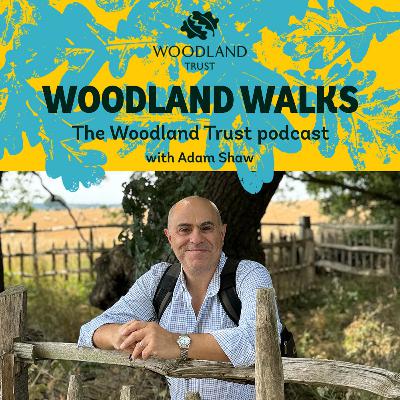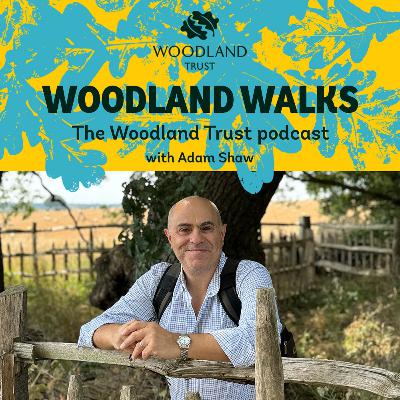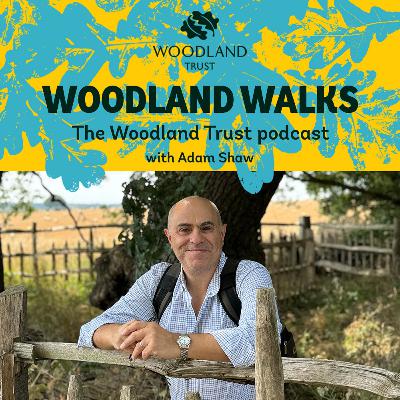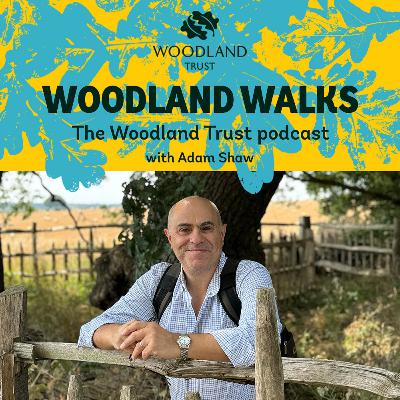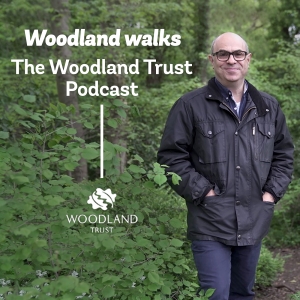19. Day 79 with 'Tree Pilgrim' Martin Hügi
Description
Sheltering from the rain under a yew tree in a Shrewsbury churchyard, we chat to 'Tree Pilgrim' Martin Hügi, the Trust's outreach manager in the South East. He's taken a four-month sabbatical to walk from Land's End to John O'Groats and visit thousands of incredible trees along the way. Hear Martin on awe-inspiring trees that have rendered him speechless, the vital Ancient Tree Inventory that helped plan the route, the value of 'plugging in' to nature and what's in his kit bag! We also hear from Adele, who explains that old trees like those on Martin's pilgrimage are not protected or prioritised like our built heritage. Find out what you can do to help.
Don't forget to rate us and subscribe! Learn more about the Woodland Trust at woodlandtrust.org.uk
Transcript
You are listening to Woodland Walks, a podcast for the Woodland Trust presented by Adam Shaw. We protect and plant trees for people, for wildlife.
Adam: Today I am off to meet the Tree Pilgrim, which is the moniker of Martin Hugi, who is doing a proper marathon pilgrimage from Land's End to John O'Groats using the Woodland Trust's Ancient Tree Inventory, so you're gonna visit a huge number of ancient and veteran trees, something like 6,500 of them he's expecting along his walk and I caught up with him in Shrewsbury in Shropshire, which is just on the River Severn about 150 miles or thereabouts, north, north west of London, and I caught up with him at a rather rainy churchyard. This is very unusual because normally I join people on walks, but actually you've been walking for what, what day is it?
Martin: I'm on day... 79 today
Adam: You had to think about that!
Martin: I had to think about that.
Adam: Yeah. So this is so you've actually taken a break and you've come into Shrewsbury and we're, we're we are in a green space in a churchyard where, now we're we're here for a special reason. Why?
Martin: So last night I was giving a talk, talking about ancient trees and the the need for greater protection and just telling my story of what I've been up to.
Adam: Right, well, first of all tell me a bit about this pilgrimage you're going on.
Martin: Yeah. So I'm calling it an ancient tree pilgrimage and it is a walk from Land's End to John O'Groats and I spent 12 months planning meticulously a route between some of the most amazing trees that I could fit into a north-south route and working out the detail of how I wassgoing to get to those trees via other trees on the Ancient Tree Inventory.
Adam: So the Land's End to John O'Groats, which that walk, famous sort of trip which is called LEGO for short, is it?
Martin: LEJOG, or JOGLE if you go the other way.
Adam: LEJOG, right OK, LEJOG.
Martin: Land's End to John O'Groats.
Adam: OK. It's long if you do it straight, but you've gone, gone a sort of wiggly woggly way, haven't you? Because you're going actually via interesting trees. So how many miles is that gonna be?
Martin: Yeah, that's right. Yeah. Well, it's if you're going to go a sort of more classic route, it would be something like 1,080 or 1,100 sort of miles. The route that I've planned is 2,077 miles.
Adam: Wow.
Martin: So it's double.
Adam: 2,077 mile walk.
Martin: Yeah, I had estimated doing 18 miles a day. That would be, that was my average. I'd sort of planned rough stops where I thought I might be able to get to. I'm more doing about 13 miles a day, which is not a lot less, but it's, I'm spending more time with the trees. And I, we also we lost our our dog on the day that I was setting off. We went down to Penzance to start and we took our our old family dog with us and he was very old and and elderly and he actually died on the morning that I was going to set off. So we just drove back home and didn't fancy starting again for another couple of weeks. So if you can be behind on a pilgrimage, I was already 2 weeks behind, but actually, I'm on a pilgrimage, so it's it's it's about the journey.
Adam: Would you say you're a religious person?
Martin: Not in the classic sense of an organised religion, but I, I do have a spiritual side to me for sure. Yeah.
Adam: And what difference then, you you talk about this tree pilgrimage and it not being about the distance, it's about the journey, which, you know, one often hears. What, if anything, have you learnt about your feelings for the natural world, or what you think it can offer you, or what you can offer it during this journey so far?
Martin: Yeah, I think I'm learning about my connection with nature and ancient trees and the sites that they sit in as being good places to access that connection. So one of the stories that I tell is about meeting the Majesty Oak in Fredville Park in Kent. And we went with a conservation trip with work and it's just such an incredible tree at it's 12.5 metre girth and a maiden oak. And it just goes straight up and it's just it's, it's, it's bulk, it's sheer dominance and size literally blew my mind to the point where I was speechless for a couple of minutes and I wasn't the only one, and because I think it it just it takes you out of the ordinary state of 'this is what a tree is' and it put me into a state of, this is something different, and it was a a real feeling of awe and I get that from ancient trees, I sometimes I will feel awe and that's a a rare feeling in my life and potentially a lot of people's lives. And I think that's well, that's what I'm seeking, I suppose, but it's almost like a gateway feeling for other potential feelings that you can cultivate around nature and trees. Just things like respect and gratitude, and I've actually found myself thanking some of the trees because of, they're just full, so full of life and and they're persisting and the resilience and feeling actual gratitude that they persist and doing what they do.
Adam: And you must meet a lot of people on your walk. 70 odd days in so far, they must ask you what on Earth you're doing and must give you some sort of response. What, have people been surprised, shocked, do they think you're nuts? Do they go 'can I join you'? What's been the response?
Martin: All of those things, I suppose. Yeah, I'll, I'll sort of tell them what I'm doing and and as soon as I get to Ancient Tree Inventory, I get a blank look.
Adam: OK. Well, you say lots of people don't know about this, let's talk about this. First of all, what is it, and then how do people get involved?
Martin: Yes. So it is a citizen science project, it's an open publicly accessible data set of ancient trees across the UK.
Adam: And so I could, I mean, for instance, today if we think we found this ancient tree, we would go on the register and go, here it is, we think it's a, you know, a an ancient oak or what whatever it is and we measure its girth, its its width at about do you do it about 3 metres high? Is that what you meant to do?
Martin: It's 1.5 metres.
Adam: So only twice wrong *laughs* there we are, well a good margin of error. Yeah, 3 metres is too high. No, I'm short as it is, overblown idea of how tall I am. So 1.5 metres high you sort of take a tape measure and you measure it and you say you you think you you know what it is, you give it a good go and there's lots of online apps you can help you. And you sort of make comments about the tree. You sort of say it's in this sort of condition, but you don't have to be an expert, it is just fine to give it give it a go.
Martin: Absolutely and and actually you don't need a tape measure, you can you can make an estimate and if you don't know what the tree is exactly or don't know what it is at all, you can still add it to the inventory and it will, it won't appear as a public facing record at that point, but it will show up to an ancient tree verifier, a volunteer ancient tree verifier. It will show up as an unverified tree and and I I am an ancient tree verifier, since 2008, and I'll be able to see that there's an unverified tree here and I can go along, I can say, well, it is an oak and I can measure it if I can measure it, if it's possible. And I can record other details about the tree like its veteran characteristics.
Adam: So already, I mean I don't get too bogged down into all of this, but I get notable trees like an event has happened under them, and there's lots of amazing trees where the Magna Carta was signed under one the Tolpuddle Martyr, the first ever union was created under a tree, so there's lots of historically important trees like that. But the the difference between veteran and ancient, is there a clear distinction between those?
Martin: No, in a way it's a subjective thing, but there is guidelines. There are, for different species, there are graphs saying if it's over this sort of girth you you would, it would be erring into an ancient tree. And and different species and different growth rates so there'll be different sizes. My, so a sort of colloquial definition is it's a tree that makes you go wow, would be an ancient tree and be that awe inspiring sort of feeling. But then also an ancient tree is one where you can see that it's been through multiple stages of growth, and what you'd say as a development phase for a tree, so an oak tree for example, you'd be able to see that it's it's, it's gone up and it's done it's mature oak, it's lost limbs and then it's shrunk back down again and then it's gone back up again and then it's come back down again and it's gone back up again and you can see that history in the shape and form of an ancient tree. So an ancient tree is a veteran tree. It's just that it's been a veteran multiple times and it's gone through them.
Adam: And presum


